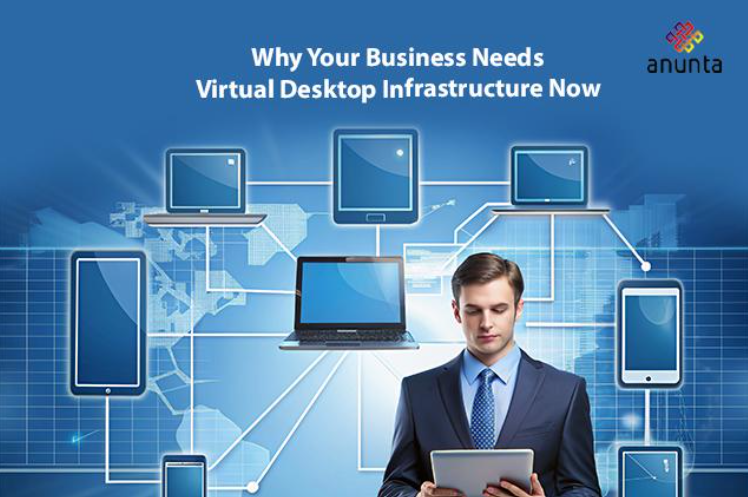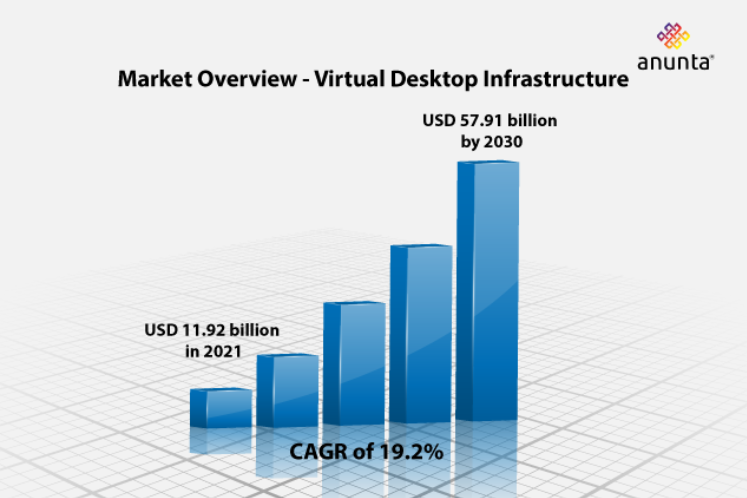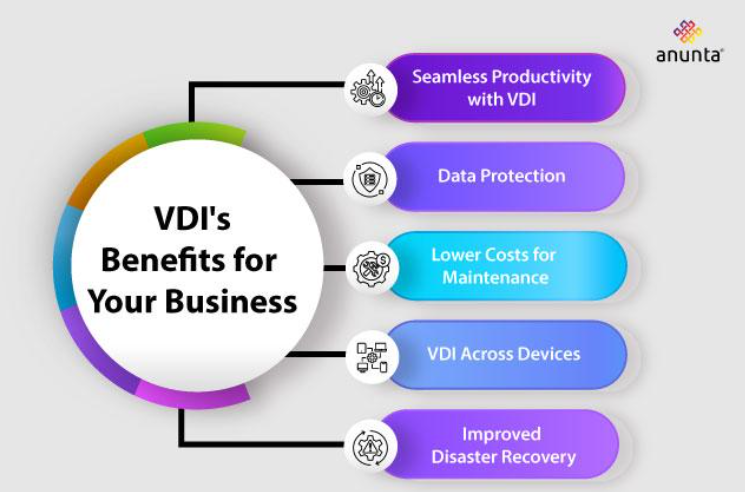
The rising cost of IT equipment is putting significant pressure on businesses today. To stay updated with the latest technology and provide employees with efficient, modern workspaces, substantial capital investment is needed. However, using Virtual Desktop Infrastructure (VDI) presents a cost-effective alternative. VDI reduces the need for expensive, high-speed on-site computers and minimizes the demand for system maintenance by technicians. It enhances security and fosters an environment conducive to steady business growth.

Virtual Desktop Infrastructure (VDI) allows you to access enterprise systems from any device, be it a personal computer, smartphone, or tablet, eliminating the need for your company to provide and manage physical machines. Authorized users can securely access company servers, files, apps, and services from any approved device via a desktop client or browser.
VDI enables traditional desktop workloads on centralized servers, becoming the go-to solution for businesses supporting remote and branch office workers, as well as contractors and partners. It safeguards sensitive company apps and data, which can run from secure data centers, allowing users to use their own devices without mixing personal data with corporate assets.
There are various ways to deliver virtual desktops and apps to users, including VDI, Desktop as a Service (DaaS), and personalized Cloud PCs. These services are increasingly popular due to improved security, performance, centralization, lower hardware requirements, cost savings, and the ability for employees to work from anywhere in the world.
Market Overview
The virtual desktop infrastructure market, which was worth USD 11.92 billion in 2021, is expected to reach USD 57.91 billion by 2030, growing at a CAGR of 19.2% from 2022 to 2030.

Globalization is pushing companies to deliver swift and efficient work for their employees. With rapid technological advancements, the demand is rising exponentially, making it difficult to forecast IT expenses. The usable lifespan of computers is also decreasing. A VDI helps businesses better manage their technology budgets.
Additionally, implementing VDI offers several other benefits for businesses:

Cloud-based desktops ensure business continuity during disruptions like hurricanes, power outages, and WFH during a pandemic. Is your primary PC out of service? Can’t reach the office? Office space uninhabitable? Working from home indefinitely? No problem. VDI provides employees with alternative access to their corporate desktops and familiar apps. This virtual desktop solution works on any device with a browser, from any location.
VDI is a versatile remote desktop solution for various scenarios: employees and contractors working from home, traveling, hot desking, or using co-working spaces. It provides a fast, complete desktop experience and secure access to essential information and applications on both company-owned and BYOD devices, anywhere with an internet connection
In a virtual desktop environment, all data is stored on the server, which also handles the necessary backups. This eliminates the risk of critical information being stored on individual workstations, thereby preventing potential disruptions in business operations due to technical issues.
One of the key advantages of virtual infrastructures is the reduction of potential risks. With no local data access, users cannot introduce computer viruses into the system, either intentionally or unintentionally. In a Virtual Desktop Infrastructure setup, workstation PCs do not require drives or interfaces, which could pose a threat to the entire system. Users cannot install their own programs, thus protecting sensitive information. Consequently, individual workstations no longer need firewalls or antivirus software, as data protection is centrally managed on the VDI server.
In a virtual network, workstations serve as basic input and output devices linked to the server’s virtual workstation. The server manages all software maintenance, allowing workstations to focus solely on hardware upkeep. This setup completely avoids workstation issues caused by improper software installation or usage. Users can only use the server’s software on virtual interfaces to complete their tasks. The virtual workstations, set up on the server, can be customized to meet the specific needs of each individual workstation if necessary. Employees have access to only the essential software they need for effective work design.
Physical devices are a constant challenge for IT, with Forrester reporting that 67% of organizations expect to replace corporate-owned laptops every three years. In contrast, VDI (Virtual Desktop Infrastructure) is device-agnostic, allowing users to securely access their VDI environment from any device with an HTML5-compatible browser and internet connectivity. This extends the service life of laptops, tablets, and thin clients.
In a VDI setup, the performance of the user’s device is not a limiting factor. Instead, cloud-based hardware, particularly optional GPU hardware in a hosted private cloud, drives higher performance, essential for graphically intensive and compute-heavy workloads.
System failures and security breaches occur daily. For businesses relying on local desktop storage, this can lead to significant operational downtime, causing employees to wait until devices are functional to resume their tasks.
VDI offers a more reliable and optimal solution, with data storage, backup, and recovery managed on a cloud server. Consequently, during disasters or system failures, users can effortlessly access their virtual desktops and recover files from any location, ensuring continuous business operations.
Businesses transitioning to cloud computing need a user-friendly cloud environment with top-notch security. Anunta is the ideal virtual desktop solution for these needs, offering computer resources accessible on PCs and tablets with internet connectivity.
Our services include comprehensive security solutions, advanced threat detection, and responsive capabilities to minimize cyber threats. In addition to security, we provide 24/7 customer support with experts ready to assist you anytime. Looking for a secure, easy-to-use virtual desktop solution with exceptional service? Reach out now to find out how we can protect your business.
Although desktop virtualization is a relatively new concept, demand remains high. The benefits of Virtual Desktop Infrastructure are particularly advantageous for businesses with complex workplace needs, from established firms to growing startups with increasing IT demands. Virtual networks can scale to meet your company’s needs, eliminating the costly and inconvenient replacement of numerous desktop computers. With one click, you can create a customized VDI that fits your company’s requirements and supports growth.
Also Read: What is Application Virtualization
A: VDI is a technology that allows you to access your desktop environment from any device, such as a computer, smartphone, or tablet, by connecting to a centralized server. This means you don’t need to manage physical computers for each user.
A: Virtual Desktop Infrastructure reduces the need for expensive on-site computers and lowers maintenance costs since most of the management and updates are handled on the central server. It also extends the life of existing devices and cuts down on hardware expenses.
A: The main benefits of VDI include enhanced data security, lower maintenance costs, the ability for employees to work from anywhere, and improved disaster recovery options.
A: Yes, VDI is ideal for remote work. It allows employees to access their work desktops and applications from anywhere, using any device with internet access.
A: Virtual Desktop Infrastructure stores all data on a secure server rather than on individual computers. This centralization helps protect sensitive information and reduces the risk of data loss or security breaches.
Research Review with Anunta’s CTO | Jan 14 | 12PM PST/3PM EST